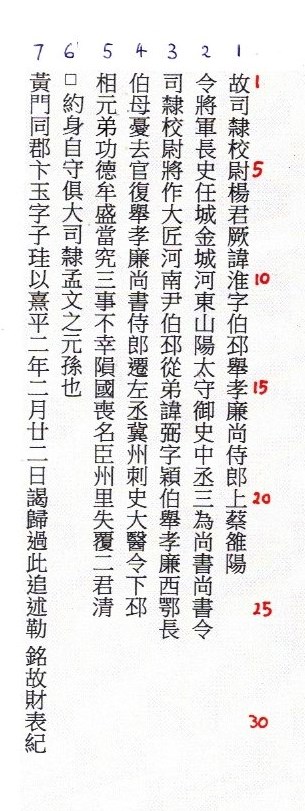
Yang Huai Biao Ji 《楊淮表紀》 is one of the famous cliff carvings in the Eastern Han Dynasty. The full name is 《司隷校尉楊淮從事下邳相弼表紀》. It is the epitaph of two important officials, Yang Huai (楊淮) and his brother Yang Bi (楊弼). The epitaph was composed by Bian Yu (卞玉) and the characters were engraved on a cliff in the second year of Xiping (熹平二年) in the Eastern Han Dynasty (173 CE). Bian Yu passed by Shimen (石門) in Baogu, Shaanxi (陝西褒谷). He probably saw the cliff engraving of Shimen Song (石門頌) of 148 CE in memory of the government official Yang Meng-wen (楊孟文). Yang Meng-wen was credited with the repairing and re-opening of the once blocked major pathway of Baoyedao (褒斜道) to the western part of the country.
Yang Huai (楊淮) and Yang Bi (楊弼) were the grandsons of Yang Meng-wen (楊孟文). Yang Huai (楊淮) was once the Prefects of Rencheng (任城), Jincheng (金城), Hedong (河東), Sanyang (山陽) and other important posts. He was finally promoted to the top rank of Si Li xiao wei (司隸校尉) inspecting and supervising other officials in the government (監察官職). His grandfather also held that high rank.
Yang Huai Biao Ji 《楊淮表紀》was engraved on a cliff on the south side of ‘Shimen Song’ on the west wall of Shimen in Baogu in 173 CE, 25 years after the engraving of Shimen Song. The 171 characters were engraved in 7 vertical columns. The number of characters varies from 15 to 31. The average width of the characters is about 6 cm. The lengths of the characters vary from around 4 cm to 9 cm. The style of the writings are very similar to that of Shimen Song (石門頌), quaint (古撲) but lively (活潑). The stone was recently moved from the cliff to Hanzhong Museum (漢中市博物館).
A comparative study of two ink rubbings
The ink rubbing on the right hand side is copied from 二玄社書跡名品叢刊 第八七回配本 (1962)(Nigensha Co, Ltd). The one on the left comes from 今日頭條.
In 二玄社’s copy, the distances between the characters have been kept as in the original cliff engraving, whereas in 今日頭條’s copy, the distances between the characters have been reduced. Characters are more packed together.

The text of the stele is as follows:
故司隸校尉楊君,厥諱淮,字伯邳。舉孝廉、尚書侍郎,上蔡雒陽令,將軍長史、任城、金城、河東、山陽太守。御史中丞,三為尚書,尚書令。司隸校尉,將作大匠,河南尹。伯邳弟諱弼,字穎伯,舉孝廉,西鄂長。伯母憂,去官。復舉孝廉,尚書穎侍郎。遷左丞,冀州刺史,大醫令,下邳相。元功德牟盛,當究三事,不幸早隕。國喪名臣,州里失覆。二君清□,約身自守,俱大司隸孟文之元孫也。黃門同郡卞玉,字子珪,以熹平二年二月廿二日謁歸過此,追述勒銘,故財表紀。
My copy of the full text of the stele is as follows.
After I had written the characters in square grids, I discovered that the length of the characters vary and the characters should not be placed uniformly in square grids. I could have written with variable number of characters in each column instead of 5 characters per column.

I compared the characters of Shi Men Song (石門頌) with Wei Yang Biao Ji (楊淮表紀) and found that the characters of Shi Men Song are mostly arranged uniformly in square grids.

The characters have been put together more closely packed together in the following ink-rubbing.



The characters intertwined beautifully together, the above ink-rubbing may not be made from original rock. It may be a recut, retouched and modified carving (翻刻修繕拓本). The characters might be copied precisely from the original rock and put together by a highly competent calligrapher. The intertwining of the characters add additional aesthetic value to the piece.
In terms of calligraphy in the Eastern Han Dynasty, both Shimen Song (石門頌) and Yang Huai Biao Ji (楊淮表紀) are equally important as they compliment each other.
Bibliography
https://baike.baidu.hk/item/%E6%A5%8A%E6%B7%AE%E8%A1%A8%E7%B4%80/12380092
https://kknews.cc/history/ezkv8rz.html明拓漢《楊淮表紀》
https://baike.baidu.com/item/%E6%9D%A8%E6%B7%AE%E8%A1%A8%E7%BA%AA/12380092
黃公渚 (1966) 兩漢金石文選評注 香港太平書局
俞丰 (2009) 經典碑帖釋文譯注, 上海書畫出版社 , ISBN 978-7-80725-846-9
Ouyang Z S, W C Fong, Y F Wang (2008) Chinese Calligraphy, Yale University, ISBN 978-0-300-12107-0
































